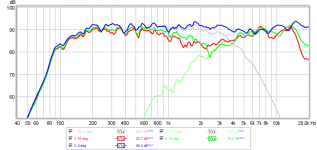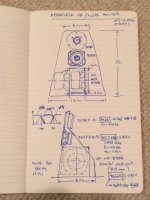So a vertical polar at 0deg, 30deg, and 45deg should confirm if this is happening then? 30deg should have deep null?
Guess so, bear in mind the 100mm ctc distance set in XDir is a guess looking your OB pictures and if this is way off must have precise data then.
Because you use advanced Harsch XO with a certain delay setting and to rule out if any misalignment in acoustic center alignment suggest take measurements every 10º to give better picture
Vertical polar of MTM
Byrtt,
There is some lobing, but it appears to be a soft effect and 10dB deep at 2.4kHz. On the other hand, the response in the HF is very good up to a high frequency with minimal variation.
This is at 0 deg, 30 deg, 45 deg with TG9FD-DC28F-TG9FD.
Byrtt,
There is some lobing, but it appears to be a soft effect and 10dB deep at 2.4kHz. On the other hand, the response in the HF is very good up to a high frequency with minimal variation.
This is at 0 deg, 30 deg, 45 deg with TG9FD-DC28F-TG9FD.
Attachments
Byrtt,
There is some lobing, but it appears to be a soft effect and 10dB deep at 2.4kHz. On the other hand, the response in the HF is very good up to a high frequency with minimal variation.
This is at 0 deg, 30 deg, 45 deg with TG9FD-DC28F-TG9FD.
Okay a smiling response with a null dip at 30º thanks plots its not invincible and makes some difference compared to had it been a single TG9FD at these angles, you right higher HF is very good where tweeter gets on its own.
Last edited:
Some articles on controlled directivity
Linkwitz "Controlled Directivity" loudspeaker page
Directivity in loudspeaker systems (Geddes)
And here is a statement from Geddes conclusion "The Summa has a particularly high directivity, which is desirable in a small room (another topic altogether)."
The more I think about this and my experience with my dipole acoustat electrostatics, this little DQ25/TG9 experiment, and my waveguide experiments with my RS28f/Satori, I am thinking that I want to start aiming for high directivity for near-field monitor applications. And the easiest ways to create small speakers with high directivity is diploes and waveguides and maybe cardiods (sorry I can't imagine placing a pair of synergy horns at 1m near field distances, 1m apart from each other). XRK how large are your synergy/Trynergy horns (H W D)?
I also want to figure out how to do polar plots. I think barleywater posted something awhile back on this. I found this, but it is specific to the OmniMic product Polar Displays
This looks interesting http://www.artalabs.hr/AppNotes/AP6_Directivity_Measurements-EngRev1.01.pdf
Is there a free program for turning multiple off axis measurements (like barleywater posted back at #241) into polar plots or polar spectrograms?
Linkwitz "Controlled Directivity" loudspeaker page
Directivity in loudspeaker systems (Geddes)
And here is a statement from Geddes conclusion "The Summa has a particularly high directivity, which is desirable in a small room (another topic altogether)."
The more I think about this and my experience with my dipole acoustat electrostatics, this little DQ25/TG9 experiment, and my waveguide experiments with my RS28f/Satori, I am thinking that I want to start aiming for high directivity for near-field monitor applications. And the easiest ways to create small speakers with high directivity is diploes and waveguides and maybe cardiods (sorry I can't imagine placing a pair of synergy horns at 1m near field distances, 1m apart from each other). XRK how large are your synergy/Trynergy horns (H W D)?
I also want to figure out how to do polar plots. I think barleywater posted something awhile back on this. I found this, but it is specific to the OmniMic product Polar Displays
This looks interesting http://www.artalabs.hr/AppNotes/AP6_Directivity_Measurements-EngRev1.01.pdf
Is there a free program for turning multiple off axis measurements (like barleywater posted back at #241) into polar plots or polar spectrograms?
Last edited:
I forget how small your space is. Trynergy is 22in wide x 14in high x 16in deep IIRC. Maybe a simple 45deg tractrix waveguide adapted for your DQX may work?
PRV Audio WG16-25-B 1" 45 x 45 ABS Elliptical Tractrix Waveguide 2/3-Bolt
PRV Audio WG16-25-B 1" 45 x 45 ABS Elliptical Tractrix Waveguide 2/3-Bolt
Nice. What drivers are uses in the cardioid sub? Is the response down to single Hz?
Monopole sub is Peerless 830500 XLS in 14" x 14" x 20" sealed box; dipole sub is Dayton RSS315HF-4 in 14" x 14" x 20" U-frame. Monopole is stacked on top of U-frame placed on floor.
Crossover to Pluto is 90Hz FIR filters. Sub system is run mono.
Frequency response:
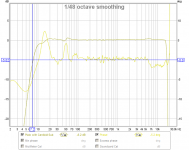
Setup is capable of square waves from 8Hz-3.5kHz.
I find this system does piano like no other; If you have ever heard grand piano up close on live floor being hammered on with dampers peddle being pumped like kick drum, the floor moves.
Acoustic bass also transmits lots of energy to floor.
jeshi;
Most modern nearfield monitors with tweeters employ waveguides that produce directivity similar to 3"-4" full range driver. The waveguide forces center to center distance to grow, incurring lobe behavior at crossover frequency. Typical tweeter with waveguide still requires crossover >1500Hz to avoid IM.
With X's reference monitor with 10f, crossover 400Hz-500Hz avoids major lobe issues, and still produces fairly broad sweet spot for HF. Imaging is superior, because at crossover frequency speaker behaves as single source, instead of two sources.
High directivity for nearfield monitoring is unnecessary because direct to reflected ratio is high enough so that stereo effects and reverberation in recording dominate perception.
Polar plot presentation is mostly a mater of style. All stem from set of IR measurements. The simple black and white presentations in Stereophile with normalization to on axis response are easy to interpret. Normalized plots I have presented as overlay view with REW are easy to create and are quite similar to the Stereophile standard. Toughest part is making good set of measurements. Rotating speaker about vertical axis through highest frequency driver's voice coil with fixed microphone position is easiest for horizontal directivity plots. Vertical plots are easiest by moving microphone. If doing vertical plots regularly, a good microphone boom is handy, it is placed 90 degrees off axis with pivot aimed at HF driver's voice coil. Boom is pivoted in circular arc that keeps fixed microphone distance from voice coil. Instead of voice coil, tweeter dome or driver dust cap often make better reference point.
Barleywater, thanks. I agree with your comments about current nearfield monitors and waveguides. I own one (focal CMS40). And almost all commercial nearfields that I have heard, crossover in the 2000-35000hz range for IM, and integration so that you hear one speaker and not two drivers.Most modern nearfield monitors with tweeters employ waveguides that produce directivity similar to 3"-4" full range driver. The waveguide forces center to center distance to grow, incurring lobe behavior at crossover frequency. Typical tweeter with waveguide still requires crossover >1500Hz to avoid IM.
With X's reference monitor with 10f, crossover 400Hz-500Hz avoids major lobe issues, and still produces fairly broad sweet spot for HF. Imaging is superior, because at crossover frequency speaker behaves as single source, instead of two sources.
High directivity for nearfield monitoring is unnecessary because direct to reflected ratio is high enough so that stereo effects and reverberation in recording dominate perception.
But I think I need to disagree with you that direct reflections do not matter for nearfield monitors. Every studio I know of whether a project studio or a large one, uses room treatment to tame the direct reflections. Just looking at a typical small studio like this example, and it is clear there are many possibilities for near-by direct reflections (LCD monitors, walls, desk, equipment...), and it is clear he had the room custom made with angled, curved walls, no corners, and treatment to minimize direct reflections.

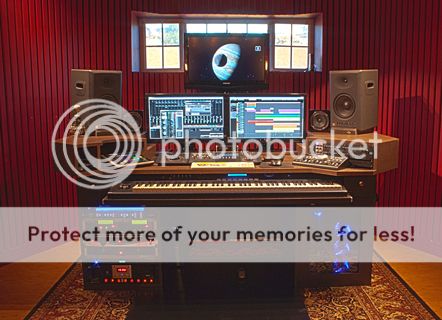
I think a highly directive speaker would work well in a nearfield application and may require less room treatment than a convention speaker. Plus I know what I am hearing with this little DQ25/TG9. I am going to continue to pursue this design which is currently showing very strong directivity (OB dipole, plus some vertical lobbing due to the spacing/XO effect). And talking with XRK, he is also thinking his 4khz crossover TG9/dome/TG9 is sounding "magical".
Jeshi,
Thanks for introducing us to the idea of a TG9FD and dome tweeter in a small OB as a desktop or nearfield monitor. I think your speaker idea is very cool and it looks like we will be talking about it a lot. You may want to either create a new thread or ask the mod team to move the posts for this topic to a new thread. I will certainly be following it over there. This thread really is a great place to learn more about all the neat things that EVA can do for a speaker.
Thanks,
X
Thanks for introducing us to the idea of a TG9FD and dome tweeter in a small OB as a desktop or nearfield monitor. I think your speaker idea is very cool and it looks like we will be talking about it a lot. You may want to either create a new thread or ask the mod team to move the posts for this topic to a new thread. I will certainly be following it over there. This thread really is a great place to learn more about all the neat things that EVA can do for a speaker.
Thanks,
X
Monopole sub is Peerless 830500 XLS in 14" x 14" x 20" sealed box; dipole sub is Dayton RSS315HF-4 in 14" x 14" x 20" U-frame. Monopole is stacked on top of U-frame placed on floor.
Crossover to Pluto is 90Hz FIR filters. Sub system is run mono.
Frequency response:
View attachment 508501
Setup is capable of square waves from 8Hz-3.5kHz.
I find this system does piano like no other; If you have ever heard grand piano up close on live floor being hammered on with dampers peddle being pumped like kick drum, the floor moves.
Acoustic bass also transmits lots of energy to floor.
Having extension to 17 Hz -3 dB myself I agree with this. I've had the arrays extended to mid 30 Hz for a while (thought it was saver for the drivers) and while the music sounded pretty good it's just not the same experience. Bringing back the low end was way more engaging. I do feel my floor move at ~85-88 dB listening levels. It brings to life a lot of songs. Piano is indeed one of the instruments that benefit. Even though we might not hear a tone at 20 Hz all that well until it reaches a certain dB level it does bring something extra to the listening experience.
Monopole sub is Peerless 830500 XLS in 14" x 14" x 20" sealed box; dipole sub is Dayton RSS315HF-4 in 14" x 14" x 20" U-frame. Monopole is stacked on top of U-frame placed on floor.
Crossover to Pluto is 90Hz FIR filters. Sub system is run mono.
Would it be too much to ask for a pic of your setup? I , for one, would love to see that! I'm always looking for eye candy, as much as ear candy!
If you don't mind.
EVA foam compact 3way nearfield monitors
This topic started over in the thread http://www.diyaudio.com/forums/full-range/277446-eva-foam-performance-speaker-enclosures.html but we decided to split it off into a separate thread over in the multiway section. Although I will be building with the excellent EVA foam, several friends who are also interested in similar designs may build with more conventional materials. If you want to discuss the merits of EVA foam, please join into the discussion over in that thread.
Nearfield monitors are used in studios for detailed listening during the mixing, composing, recording process. Nearfield is usually defined as a listening distance of 0.4-1.6 meters. Longer listening distances than that are classified as midfield and farfield and require different design optimizations. Most DIY speakers are designed for living rooms and home theater applications and are not optimized for nearfield use.
A few things are important when designing nearfield monitors
I am also building a 2way 1"+6" monitor based on the SB Acoustics Satori MW16p-04 and Dayton RS28f. My feeling is that even though there are a few excellent 1"+8" 2ways, the 8" and 10" woofers are better suited to 3way designs. For this 2way design I am using a sealed box and adjusting bass with a linkwitz transform. I built the box with a removable baffle so that I can explore different baffle designs and carved waveguide shapes. I may also explore other tweeters in the future, but the MW16p Satori will stay.
I am starting this thread as a place to log my experiments and explorations as I build these nearfield 3way monitors and a place for others to explore similar builds. I will be asking the moderators to move the relevant discussion from my other thread over here.
This topic started over in the thread http://www.diyaudio.com/forums/full-range/277446-eva-foam-performance-speaker-enclosures.html but we decided to split it off into a separate thread over in the multiway section. Although I will be building with the excellent EVA foam, several friends who are also interested in similar designs may build with more conventional materials. If you want to discuss the merits of EVA foam, please join into the discussion over in that thread.
Nearfield monitors are used in studios for detailed listening during the mixing, composing, recording process. Nearfield is usually defined as a listening distance of 0.4-1.6 meters. Longer listening distances than that are classified as midfield and farfield and require different design optimizations. Most DIY speakers are designed for living rooms and home theater applications and are not optimized for nearfield use.
A few things are important when designing nearfield monitors
- reducing center-to-center spacing of drivers. If this is not minimized, this will lead to lack of integration of the drivers (not sounding like one speaker but instead hearing each driver separate) and less than desirable lobbing in the crossover region.
- controlling directivity and dispersion. nearfield monitors are usually placed on top of mixing decks or with keyboards and other equipment very close by and often in smallish studio spaces.
- nearfield monitors are usually designed for improved clarity and imaging, flat frequency response, but less for max SPL because of the short listening distances. They must sound good at lower SPL levels.
- compact size is important because it needs to fit into a studio space at about 1meter listening distance.
I am also building a 2way 1"+6" monitor based on the SB Acoustics Satori MW16p-04 and Dayton RS28f. My feeling is that even though there are a few excellent 1"+8" 2ways, the 8" and 10" woofers are better suited to 3way designs. For this 2way design I am using a sealed box and adjusting bass with a linkwitz transform. I built the box with a removable baffle so that I can explore different baffle designs and carved waveguide shapes. I may also explore other tweeters in the future, but the MW16p Satori will stay.
I am starting this thread as a place to log my experiments and explorations as I build these nearfield 3way monitors and a place for others to explore similar builds. I will be asking the moderators to move the relevant discussion from my other thread over here.
Last edited:
Would it be too much to ask for a pic of your setup? I , for one, would love to see that! I'm always looking for eye candy, as much as ear candy!
If you don't mind.
Shoot, I'd like to see pics of the square waves.
it will starts with my current 3way project with is the dq25/tg9 small open baffle with SLOB slot loaded open baffle dual 8" woofer. I have asked that post #288 till end in the other thread be moved over here.
I am just leaving the title and topic a little more open so that I can also include other enclosure types here without having to always start a new thread.
Sent from my iPhone using Tapatalk
I am just leaving the title and topic a little more open so that I can also include other enclosure types here without having to always start a new thread.
Sent from my iPhone using Tapatalk
DC28F/TG9FD/2x-W5-876SE SLOB NF Monitor
Jeshi,
Hope you don't mind me posting here - but I am going to follow along and try building something similar as well. I have seen that the TG9FD coupled with a silk dome tweeter sounds wonderful. I have had luck with slot loaded OB's (SLOBs) before when I used qnty 6 x 6.5in buyout polycone woofers and a TC9FD on top - see thread here. For a nearfield, I think a couple of 16ohm Tang Band W5-876SE's in parallel will work out nicely. It looks like everything will come out about 85dB sensitive after baffle step losses. The DC28F will have to be padded down from 89dB and everything will run at the native sensitivity of the TG9FD10-8 which was measured to be a little over 85dB. Here is a sketch of my plan. This is an EVA foam thread but I will have to make it out of conventional paper-faced foam core.
The 7in deep slot will have a natural -6dB/oct falloff at 480Hz and I can probably use that to advantage to design textbook LR4 or BW4 target with BW3 electrical at about 400Hz. The TG9FD will be symmetric hole-filler with Bessel 2 electrical and acoustic band pass at 400Hz and 4kHz. the DC28F-8 will be electrical and acoustic LR4 at 4kHz. These are guesses and will remain to be seen. I will do it properly this time by measuring raw FRD's and using PCD to determine acoustic offsets and design the active EQ and filters all in simulation prior to implementing in miniDSP. Hopefully, I will end up with a transient perfect B&O Hole-Filler XO.
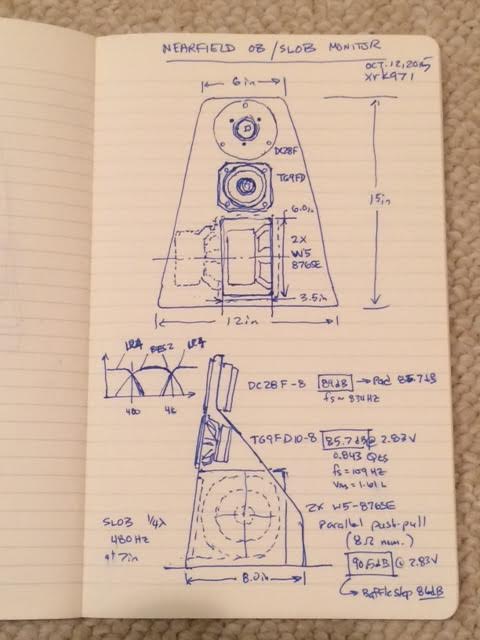
Thanks for creating this new thread.
Jeshi,
Hope you don't mind me posting here - but I am going to follow along and try building something similar as well. I have seen that the TG9FD coupled with a silk dome tweeter sounds wonderful. I have had luck with slot loaded OB's (SLOBs) before when I used qnty 6 x 6.5in buyout polycone woofers and a TC9FD on top - see thread here. For a nearfield, I think a couple of 16ohm Tang Band W5-876SE's in parallel will work out nicely. It looks like everything will come out about 85dB sensitive after baffle step losses. The DC28F will have to be padded down from 89dB and everything will run at the native sensitivity of the TG9FD10-8 which was measured to be a little over 85dB. Here is a sketch of my plan. This is an EVA foam thread but I will have to make it out of conventional paper-faced foam core.
The 7in deep slot will have a natural -6dB/oct falloff at 480Hz and I can probably use that to advantage to design textbook LR4 or BW4 target with BW3 electrical at about 400Hz. The TG9FD will be symmetric hole-filler with Bessel 2 electrical and acoustic band pass at 400Hz and 4kHz. the DC28F-8 will be electrical and acoustic LR4 at 4kHz. These are guesses and will remain to be seen. I will do it properly this time by measuring raw FRD's and using PCD to determine acoustic offsets and design the active EQ and filters all in simulation prior to implementing in miniDSP. Hopefully, I will end up with a transient perfect B&O Hole-Filler XO.

Thanks for creating this new thread.
Attachments
Last edited:
I don't mind, I was just worried that if we really keep the discussion going strong that it will get confusing when the thread gets split and the old posts get merged into here. I sent the message to the admins so now just waiting for them to split the thread. For now best to keep the discussion here until after the split happens. Hopefully the time stamps on the original posts will remain the same so after the merge it will make sense.
I love the look of this design! I am still playing with my ideas. I really want to make a landscape style in the ilk of the KH310 and ATC SCM25A since I am planning to use a pair of 8" woofers in a folded SLOB for my version and with the slot to the side of the DQ25/TG9. But this would mean a very asymetric OB for the DQ25/TG9 or having the TG9 share the W with the SLOB which might give a bit of TL-like loading.
I am planning this sort of design for my SLOB. The slot-loaded-W-frame fold rather than the large front baffle that Nelson Pass did in his first version.
Subwoofer Origami

But your woofer design is more like a W-frame open baffle rather than slot-loading.

According to Nelson Pass's original article, the slot should be smaller than the combined Sd of the drivers by a factor of around 3:1 or 4:1
I love the look of this design! I am still playing with my ideas. I really want to make a landscape style in the ilk of the KH310 and ATC SCM25A since I am planning to use a pair of 8" woofers in a folded SLOB for my version and with the slot to the side of the DQ25/TG9. But this would mean a very asymetric OB for the DQ25/TG9 or having the TG9 share the W with the SLOB which might give a bit of TL-like loading.
I am planning this sort of design for my SLOB. The slot-loaded-W-frame fold rather than the large front baffle that Nelson Pass did in his first version.
Subwoofer Origami

But your woofer design is more like a W-frame open baffle rather than slot-loading.

According to Nelson Pass's original article, the slot should be smaller than the combined Sd of the drivers by a factor of around 3:1 or 4:1
The air coming out the front is squeezed at a ratio of about 3 to 1.The rear wave not so much. Remembering that the motional energy is proportional to the square of the velocity, we expect more energy out the front than the back. The response is not symmetric – the rear wave that wants to come around and cancel at bass frequencies is not as strong as the front wave, and its ability to cancel is diminished. This is the raison d'etre of the slot loaded open baffle – greater velocity out the front and less out the back.
Last edited:
Jeshi,
I think we both have similar W frames, I may end up going with a non-push pull design to keep the mass distribution symmetric as offsetting both drivers to one side make this a very tippy speaker to one side. Not sure if that is worth the reduced 2nd order harmonic distortion reduction. I like your horizontal format concept - very handing for mixing/mastering bridges - and I think the integration of the tweeter and mid may work out better. Dual 8's is going to give you a very nice amount of bass with a total Sd of circa 440cm2 vs my 188cm2 Sd.
I think we both have similar W frames, I may end up going with a non-push pull design to keep the mass distribution symmetric as offsetting both drivers to one side make this a very tippy speaker to one side. Not sure if that is worth the reduced 2nd order harmonic distortion reduction. I like your horizontal format concept - very handing for mixing/mastering bridges - and I think the integration of the tweeter and mid may work out better. Dual 8's is going to give you a very nice amount of bass with a total Sd of circa 440cm2 vs my 188cm2 Sd.
Last edited:
I will have to play with the slot loading ratio in Akabak - making it narrow and high loading gives more efficiency but at the price of an overshoot peak right before the cutoff frequency. With a 3.5in wide x 6in tall slot I am at 1.4 compression ratio.
I would have to go with a 1.4in wide x 6in tall slot to achieve 3.5:1 compression ratio. I could do that and actually it would look nicer and allow me to make the bottom trapezoid narrower for a smaller speaker footprint. The drivers are 3.5in deep ea x 2 + 1.4in + 2in clearance = 10in wide.
I would have to go with a 1.4in wide x 6in tall slot to achieve 3.5:1 compression ratio. I could do that and actually it would look nicer and allow me to make the bottom trapezoid narrower for a smaller speaker footprint. The drivers are 3.5in deep ea x 2 + 1.4in + 2in clearance = 10in wide.
Last edited:
interesting! I just wanted to first follow Nelson Pass's formula to see if the loading works they way he says (more directional energy forward, lowering Fs), before going to more common W-H-U-Z frame. Common concern with slot-loading is that it could introduce distortion or artifacts because it is compressing and accelerating the airflow.
I want to get some real world experience with this slot-loading concept.
OK maybe this week I can start gluing and building my slot apparatus. I think I have an interesting take on how to build it since EVA is a flexible foam.
I want to get some real world experience with this slot-loading concept.
OK maybe this week I can start gluing and building my slot apparatus. I think I have an interesting take on how to build it since EVA is a flexible foam.
- Status
- This old topic is closed. If you want to reopen this topic, contact a moderator using the "Report Post" button.
- Home
- Loudspeakers
- Multi-Way
- OB compact 3way nearfield monitor
